
We have, at a number of different times, come across situations where it was desirable to use a food safe marker. One example is our
custom message hearts project, another is in the course of making
circuitry snacks. The topic came up again recently in discussions of Dan Newman’s
Nutrition Information and
Omelet Recipe eggs, where commenters were debating whether or not one should eat an egg after it has been written on.
There are three types of food safe markers readily available in the US. We tested all three in an Eggbot and just for kicks, by hand on a bit of rolled out fondant.
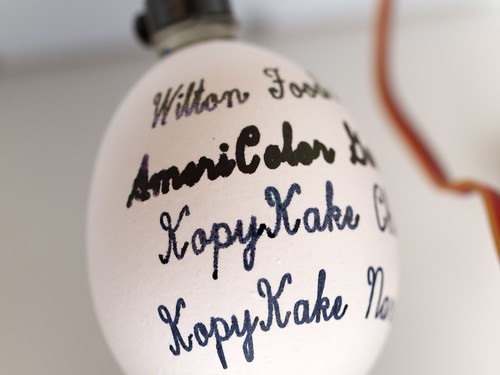
The primary differences between the markers were in the shades of the red and black, the ink flow rates, and the texture and shape of the nibs. Colors like blue, green and yellow didn’t show significant differences, although it should be noted that the blues in all cases (no matter what color the plastic was) were closer to a sky blue.
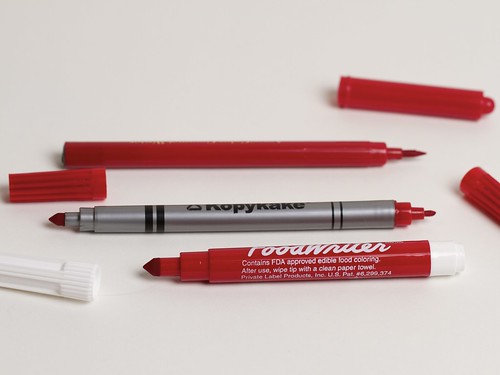

The most commonly available ones are
Wilton FoodWriter Edible Color Markers and
Foodoodler Food Coloring Markers. Both brands are made by the same company (and both are Kosher Pareve). The ones we tried were labeled “fine tip” although they are big fat markers with a conical tip. These are the ones you are most likely to find in a green and red pair at the grocery store around Christmas.
They fit in a standard Eggbot pen arm if you secure them just above the nib. They index very nicely in the wide version of the pen arm at the next stairstep up toward the barrel of the pen.
They mark fairly clearly on eggs. The red is a bit dull and the black is a bit green. On fondant, the ink quickly stops flowing and the nib catches on the surface.
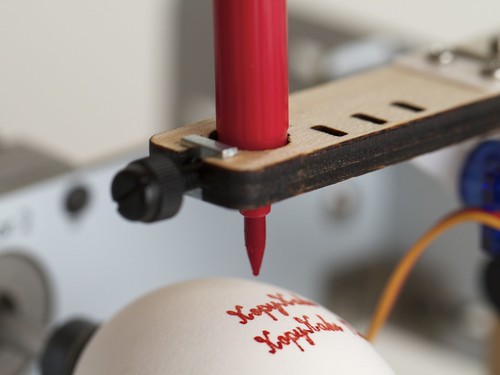 AmeriColor Gourmet Writer Food Color Markers by Ateco
AmeriColor Gourmet Writer Food Color Markers by Ateco are sold under the names AmeriColor, Ateco, Gourmet Writer, and August Thomsen. They have a long slender conical tip that is soft, almost brush-like.
They fit in the standard pen arm. The soft tip may be likely to be damaged by repeated use in the Eggbot.
The ink flows very easily, bleeds to a wide line, even without much pressure and doesn’t dry very quickly. Smearing is possible if (for instance) your servo cable is not carefully routed. The red is very bright and the black is very dark. The ink flows fine on fondant, but the nib catches, although not as badly as the FoodWriters.
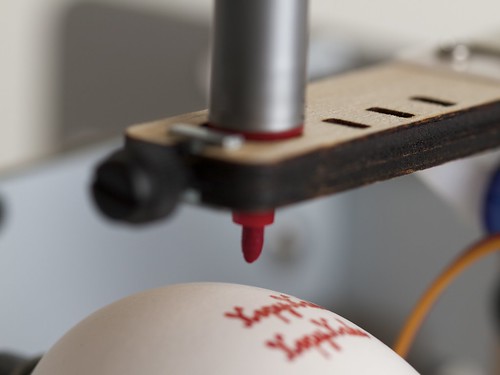
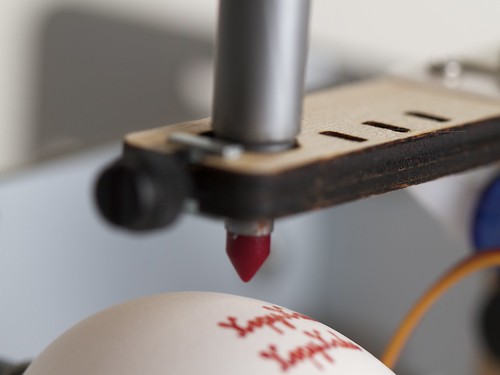 Kopykake Edible Ink Pens
Kopykake Edible Ink Pens are double ended markers with one fat conical tip and one narrower tip.
Both ends fit in a standard pen arm, and index close to the tip although they are a little more slender than is ideal. The narrow nib end is easy to index, but cannot go further into the arm. The conical nib end has an indentation that makes indexing relatively easy, although you can place the pen further down in the pen arm if desired for a more centered fit.
The red is not as dull as the Wiltons, nor as bright as the AmeriColor. The black is a little bluish. On fondant, the ink flows readily and both nibs move smoothly.
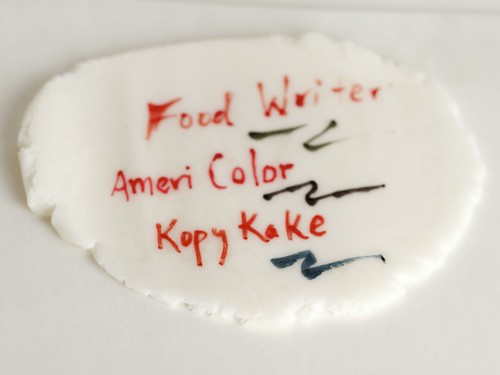
Overall, the KopyKake (narrow end) had the nicest and narrowest stroke, and was readable even with small text. It also won the quick fondant test. The AmeriColor pens had the richest colors, and were very nice for hand work on eggs, but would take quite a bit of finessing to use in the Eggbot without damaging the tips. If all you can find are the FoodWriters/Foodoodlers, they’ll work in a pinch for eggs, but may not be much fun for desserts.
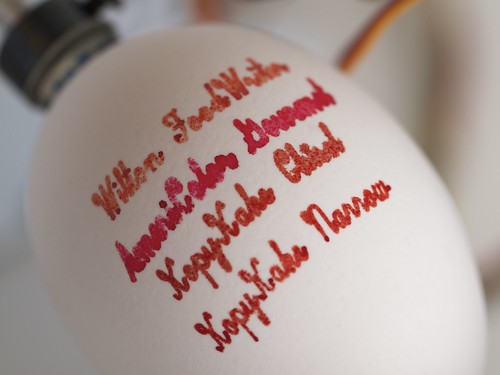
All of these inks are at least somewhat water soluble, so they smear readily if they come into contact with moisture. They were comparably smeary with decent color separation after interacting with a damp paper towel. Note that this does not mean that they are necessarily washable…

We’ve added these pens to the
Pen Choices page of the Eggbot documentation. If you know of other types, let us know in the comments. If you have tried some in the Eggbot, please do add them to the wiki!
 The primary differences between the markers were in the shades of the red and black, the ink flow rates, and the texture and shape of the nibs. Colors like blue, green and yellow didn’t show significant differences, although it should be noted that the blues in all cases (no matter what color the plastic was) were closer to a sky blue.
The primary differences between the markers were in the shades of the red and black, the ink flow rates, and the texture and shape of the nibs. Colors like blue, green and yellow didn’t show significant differences, although it should be noted that the blues in all cases (no matter what color the plastic was) were closer to a sky blue.

 The most commonly available ones are Wilton FoodWriter Edible Color Markers and Foodoodler Food Coloring Markers. Both brands are made by the same company (and both are Kosher Pareve). The ones we tried were labeled “fine tip” although they are big fat markers with a conical tip. These are the ones you are most likely to find in a green and red pair at the grocery store around Christmas.
They fit in a standard Eggbot pen arm if you secure them just above the nib. They index very nicely in the wide version of the pen arm at the next stairstep up toward the barrel of the pen.
They mark fairly clearly on eggs. The red is a bit dull and the black is a bit green. On fondant, the ink quickly stops flowing and the nib catches on the surface.
The most commonly available ones are Wilton FoodWriter Edible Color Markers and Foodoodler Food Coloring Markers. Both brands are made by the same company (and both are Kosher Pareve). The ones we tried were labeled “fine tip” although they are big fat markers with a conical tip. These are the ones you are most likely to find in a green and red pair at the grocery store around Christmas.
They fit in a standard Eggbot pen arm if you secure them just above the nib. They index very nicely in the wide version of the pen arm at the next stairstep up toward the barrel of the pen.
They mark fairly clearly on eggs. The red is a bit dull and the black is a bit green. On fondant, the ink quickly stops flowing and the nib catches on the surface.
 AmeriColor Gourmet Writer Food Color Markers by Ateco are sold under the names AmeriColor, Ateco, Gourmet Writer, and August Thomsen. They have a long slender conical tip that is soft, almost brush-like.
They fit in the standard pen arm. The soft tip may be likely to be damaged by repeated use in the Eggbot.
The ink flows very easily, bleeds to a wide line, even without much pressure and doesn’t dry very quickly. Smearing is possible if (for instance) your servo cable is not carefully routed. The red is very bright and the black is very dark. The ink flows fine on fondant, but the nib catches, although not as badly as the FoodWriters.
AmeriColor Gourmet Writer Food Color Markers by Ateco are sold under the names AmeriColor, Ateco, Gourmet Writer, and August Thomsen. They have a long slender conical tip that is soft, almost brush-like.
They fit in the standard pen arm. The soft tip may be likely to be damaged by repeated use in the Eggbot.
The ink flows very easily, bleeds to a wide line, even without much pressure and doesn’t dry very quickly. Smearing is possible if (for instance) your servo cable is not carefully routed. The red is very bright and the black is very dark. The ink flows fine on fondant, but the nib catches, although not as badly as the FoodWriters.

 Kopykake Edible Ink Pens are double ended markers with one fat conical tip and one narrower tip.
Both ends fit in a standard pen arm, and index close to the tip although they are a little more slender than is ideal. The narrow nib end is easy to index, but cannot go further into the arm. The conical nib end has an indentation that makes indexing relatively easy, although you can place the pen further down in the pen arm if desired for a more centered fit.
The red is not as dull as the Wiltons, nor as bright as the AmeriColor. The black is a little bluish. On fondant, the ink flows readily and both nibs move smoothly.
Kopykake Edible Ink Pens are double ended markers with one fat conical tip and one narrower tip.
Both ends fit in a standard pen arm, and index close to the tip although they are a little more slender than is ideal. The narrow nib end is easy to index, but cannot go further into the arm. The conical nib end has an indentation that makes indexing relatively easy, although you can place the pen further down in the pen arm if desired for a more centered fit.
The red is not as dull as the Wiltons, nor as bright as the AmeriColor. The black is a little bluish. On fondant, the ink flows readily and both nibs move smoothly.
 Overall, the KopyKake (narrow end) had the nicest and narrowest stroke, and was readable even with small text. It also won the quick fondant test. The AmeriColor pens had the richest colors, and were very nice for hand work on eggs, but would take quite a bit of finessing to use in the Eggbot without damaging the tips. If all you can find are the FoodWriters/Foodoodlers, they’ll work in a pinch for eggs, but may not be much fun for desserts.
Overall, the KopyKake (narrow end) had the nicest and narrowest stroke, and was readable even with small text. It also won the quick fondant test. The AmeriColor pens had the richest colors, and were very nice for hand work on eggs, but would take quite a bit of finessing to use in the Eggbot without damaging the tips. If all you can find are the FoodWriters/Foodoodlers, they’ll work in a pinch for eggs, but may not be much fun for desserts.
 All of these inks are at least somewhat water soluble, so they smear readily if they come into contact with moisture. They were comparably smeary with decent color separation after interacting with a damp paper towel. Note that this does not mean that they are necessarily washable…
All of these inks are at least somewhat water soluble, so they smear readily if they come into contact with moisture. They were comparably smeary with decent color separation after interacting with a damp paper towel. Note that this does not mean that they are necessarily washable…
 We’ve added these pens to the Pen Choices page of the Eggbot documentation. If you know of other types, let us know in the comments. If you have tried some in the Eggbot, please do add them to the wiki!
We’ve added these pens to the Pen Choices page of the Eggbot documentation. If you know of other types, let us know in the comments. If you have tried some in the Eggbot, please do add them to the wiki!





Thanks for writing this up Lenore. I’m curious to see if I can remove the tip from one of these pens and replace it with a replacement tip for a Copic Multiliner SP. I may need a small adapter bushing, but I won’t know until I try it. The real issue will be how the existing tip interfaces with the ink reservoir in the barrel. The Copic replacement nibs have a stiff filament which pushes into the reservoir’s fiber material which holds the ink. But, if doing this works, that should allow for even finer lines. (Yes, you can run food coloring in metal nib’d technical pens — I tried it once — but it’s too much effort to merit repeating.)
Dan
This is fabulous. Thank you! I’ve been wondering about the merits of different edible pens (even though I’ve never heard of an egg-bot until right now.)
I do edible crafts with kids, and every now and then a marker comes in handy, especially with edible dreidels.
Found this post, but I was wondering which pens dry out faster or have less ink..